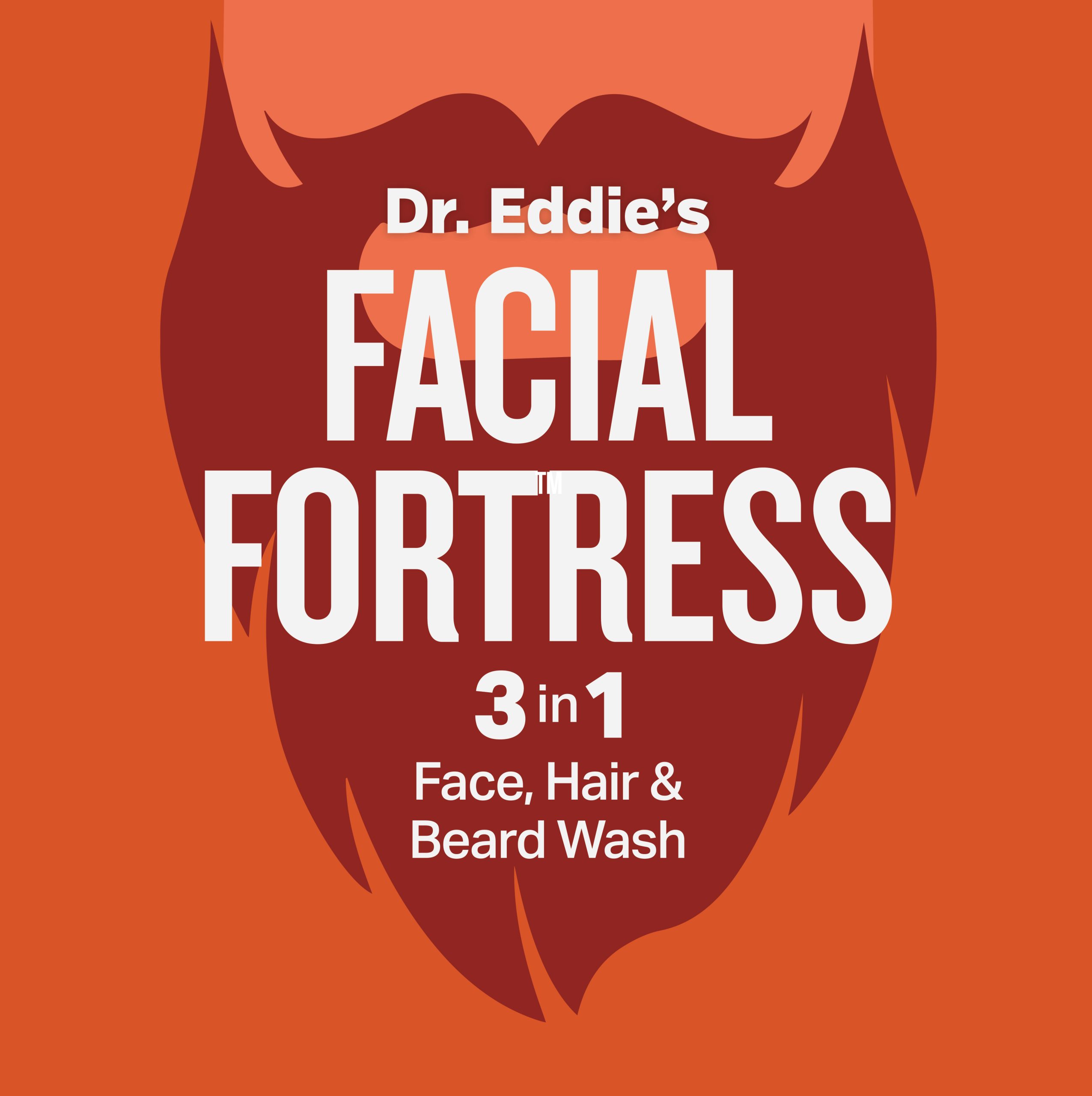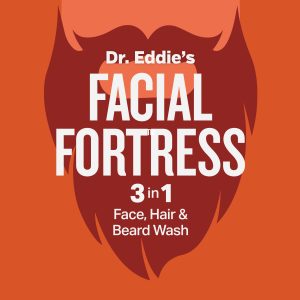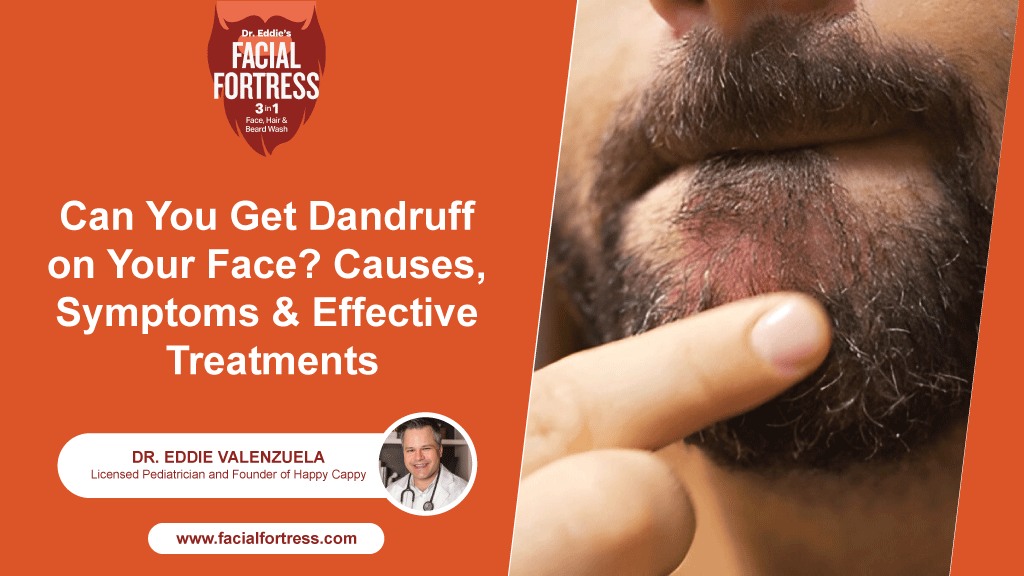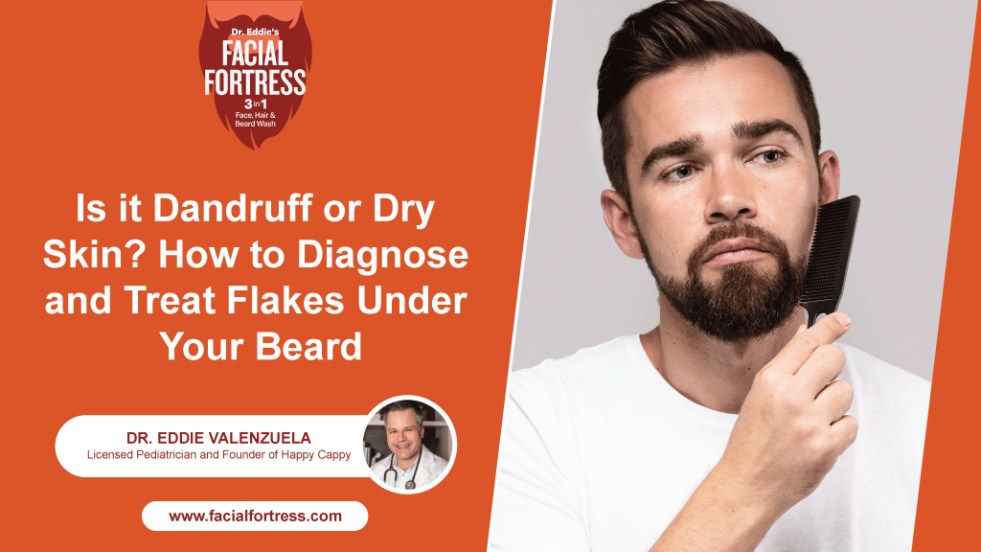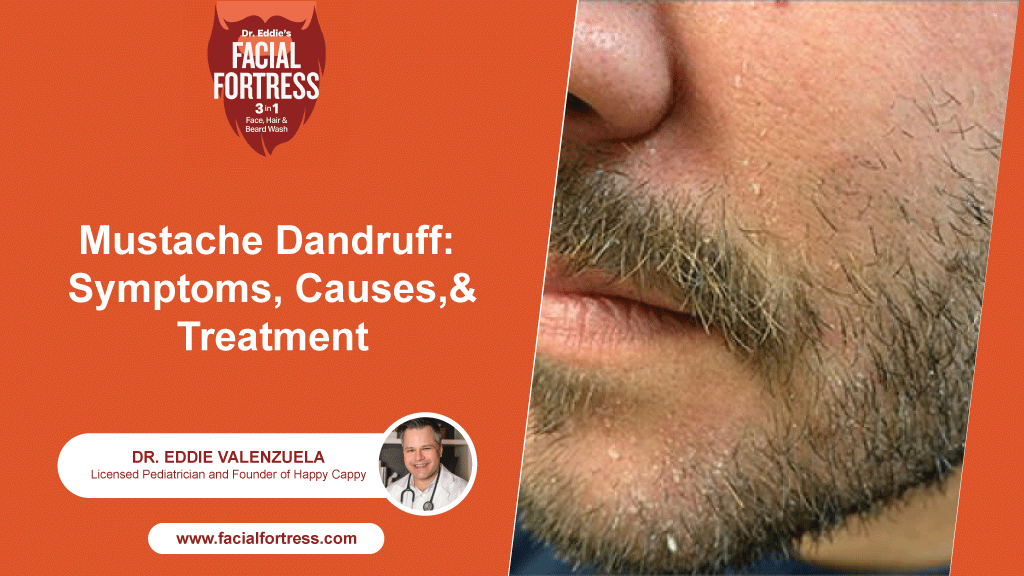Beard Dandruff? Here’s How to Fix It for Good
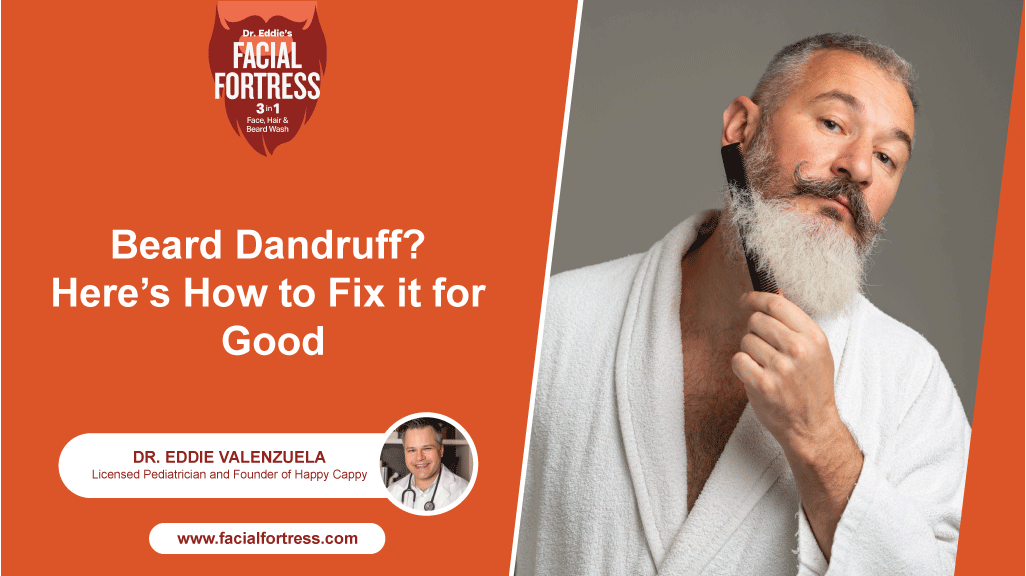
Your beard says a lot about you and it’s always visible, so keeping it crisp and well-groomed is essential. But what if one day, as you comb through it, you notice tiny, white, snow-like flakes falling from the beard onto your favorite shirt.
The worry sets in. You start wondering what this could be. Are these dry skin flakes, or could it be something else? Is it dandruff? What might be causing these flakes? How do you get rid of them?
Before you dive into endless internet research, take a deep breath and read this blog. It has answers to all your questions. From can you get dandruff on your beard to what it is, what might be causing it, and how to get rid of beard dandruff.
Can you Get Dandruff in your Beard?
The most common question about beard dandruff is, Can you actually get it? The simple answer to this question is yes! Most of us think that dandruff can only appear on the scalp.
However, the truth is that dandruff in the beard and eyebrows is as common as it is on the scalp. People who are experiencing dandruff on the scalp are more prone to developing it on the beard as well.
But don’t worry; just like scalp dandruff, dandruff in the beard can also be managed easily with the right care.
What is Beard Dandruff?
We are all pretty familiar with dandruff, one of the most common skin conditions in the world, which causes little white or yellow flakes on the scalp. Beard dandruff, or beardruff, is pretty much the same; it causes those flakes to appear on your beard.
And well, not only the flakes, but it can also cause the skin beneath your beard to become itchy. Here are some of the most common symptoms that you may notice if you are experiencing dandruff in your beard:

- Itchy skin
- Redness beneath the beard
- Greasy or oily skin
- Yellow or white flakes
- Irritation
- Brittle whiskers
The symptoms are quite similar to those of scalp dandruff because it is believed to be caused by the same fungus responsible for dandruff on the scalp.
What Causes Dandruff in the Beard?
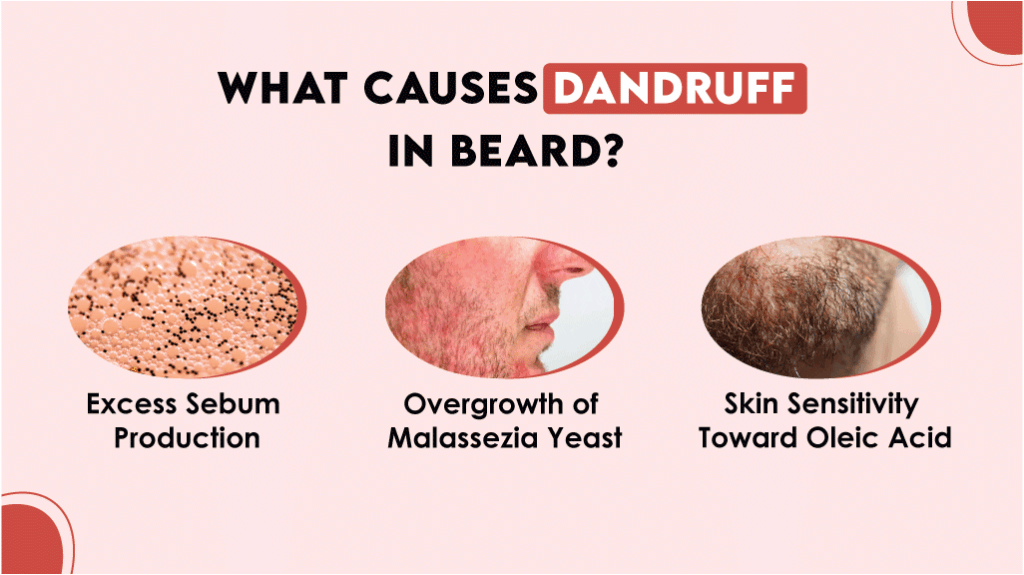
The answer to your question, “Why does my beard have dandruff?” can be found in a naturally occurring fungus on the skin known as Malassezia yeast. Yes, this yeast is present on the skin of every human being in this world, and in fact, it is essential to keep our skin and scalp healthy.
However, malassezia alone can not cause dandruff; there is a whole process that goes on behind the scenes and gives you those embarrassing white flakes.
Excess Sebum Production
Sebum is the oily substance produced by the sebaceous glands in our skin. It is a mixture of lipids, molecules, and waxes that are secreted by the glands to keep the skin and hair moisturized.
It is essential to keep the skin healthy; however, at times, due to certain factors such as genetic, hormonal changes, or certain medical conditions, the skin starts producing excess sebum.
This excess sebum can create complications later on and lead to various skin issues such as clogged pores, acne, dandruff, and seborrheic dermatitis.
Overgrowth of Malassezia Yeast
There are various types of Malassezia yeast; the one that is believed to trigger dandruff is Malassezia globosa. This yeast thrives and feeds on sebum. So, when the skin starts producing more sebum, the growth of Malassezia also increases.
Even though an adequate amount of Malassezia yeast is good for our skin, its overproduction can cause complications. When the yeast consumes the sebum, it leaves behind a byproduct known as oleic acid.
Skin Sensitivity Toward Oleic Acid
Some people have skin sensitivity towards this oleic acid. As a reaction, one may start experiencing the irritation, flaking, and redness associated with dandruff. This reaction can also affect the cell turnover cycle.
In general, new skin cells form and replace the old ones after 30 days. However, due to the reaction, the new skin cells are produced at a much faster rate. This rapid turnover leaves no time for the dead ones to fall off, and as a result, they accumulate and take the form of dandruff flakes.
Are Dandruff and Seborrheic Dermatitis the Same?
Dandruff and seborrheic dermatitis are two of the most common skin conditions experienced by people worldwide. According to a survey published by the National Institute of Health, around 50 million people in the USA suffer from dandruff.
About 3 to 10 people out of 100 are affected by seborrheic dermatitis. Most people think that seborrheic dermatitis and dandruff are the same. They may look quite similar, caused by the same fungus, and manifest similar symptoms, but the truth is they are quite different.
Seborrhic dermatitis, you can say, is a more severe form of dandruff.
It can cause thick, greasy, yellow, or white scales to appear on the scalp, eyebrows, and beard. It can also lead to redness and irritation on other parts of the body, such as around the nose, behind the ears, on the chest, and on the back, which is not very common in dandruff.
How to Get Rid of Dandruff in Your Beard?
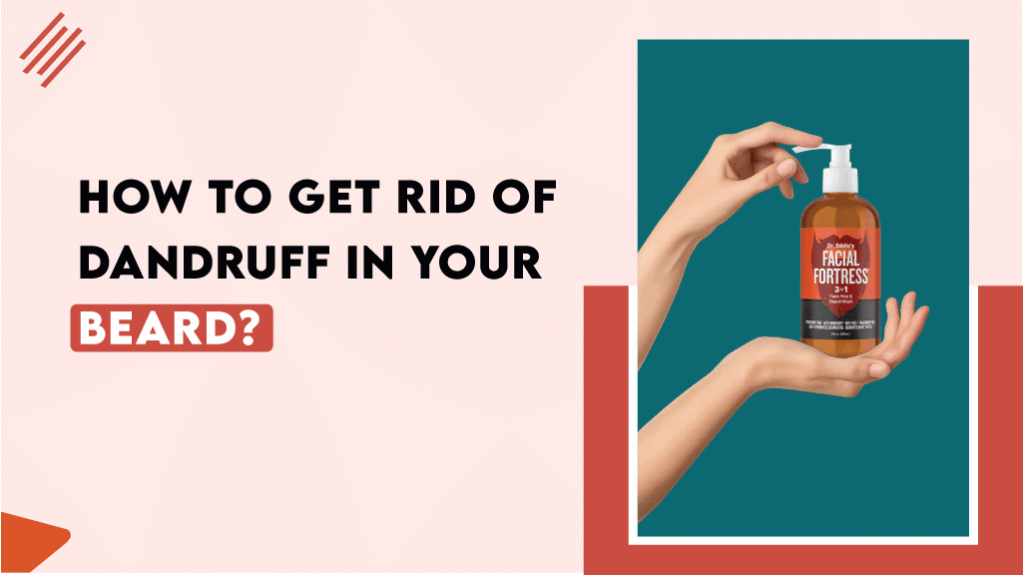
Getting rid of beard dandruff is not as difficult as it may sound. All it takes is patience, time, and precision. By following a proper beard-washing routine, you can easily remove the flakes from your beard.
Here are a few things that you can incorporate into your routine:
Cleansing
The best way to get rid of beard dandruff is to use a medicated dandruff shampoo for beard. Use it at least 2 to 3 times a week to wash your beard. A medicated beard wash that contains pyrithione zinc is a great option.
Pyrithione zinc has been known to be effective for decades in eliminating the flaking and scaling associated with dandruff and seborrheic dermatitis. Wondering how to properly use it? Here is what you must do
- Wet your beard thoroughly with lukewarm or cool water.
- Wet your hands and apply a small amount of shampoo onto your palms.
- Now gently rub them together to generate a lather, and then massage into your beard and the skin beneath it.
- Then, thoroughly rinse off the shampoo without leaving any residue behind.
- At last, gently pat your beard dry with a soft towel.
Generally, using an anti-dandruff shampoo at least 2 to 3 times a week can help.
Brushing
Exfoliating the skin under your beard is essential to keep the beard healthy and flake-free. Dandruff can make your skin greasy, which can easily trap the dead skin cells and dirt in the hair follicles and clog them, leading to other complications, such as acne.
Regularly brushing your beard can help exfoliate this buildup. Use a soft-bristled brush or a fine-toothed comb to brush your beard in a downward motion before shampooing to remove dandruff from your beard.
Brushing the beard will not only help you get rid of the flakes but also promote blood flow, which is essential for healthy hair growth. However, make sure to be gentle, as vigorous brushing can cause skin irritation and weaken the hair follicles.
Moisturizing
Just like the skin, moisturizing the beard after washing it is also essential to keep it healthy. While most people consider using beard oil to moisturize the skin, it is important to know that malassezia yeast thrives on oils, and using it on your beard can actually make your dandruff worse.
Instead of oil, use a water-based beard balm, which helps lock in moisture and keep your beard soft.
Beard Dandruff Home Remedies
When you search the internet for beard dandruff treatment, you will find various sites recommending the use of natural home remedies such as aloe vera gel, lemon juice, and apple cider vinegar to get rid of dandruff.
However, the truth is that these natural remedies can cause skin reactions in some people and worsen the condition. So, before using any of these remedies, it is best to consult a doctor or stick to a safer option, which is the use of a beard wash for dandruff.
Things That Can Make Your Beard Dandruff Worse
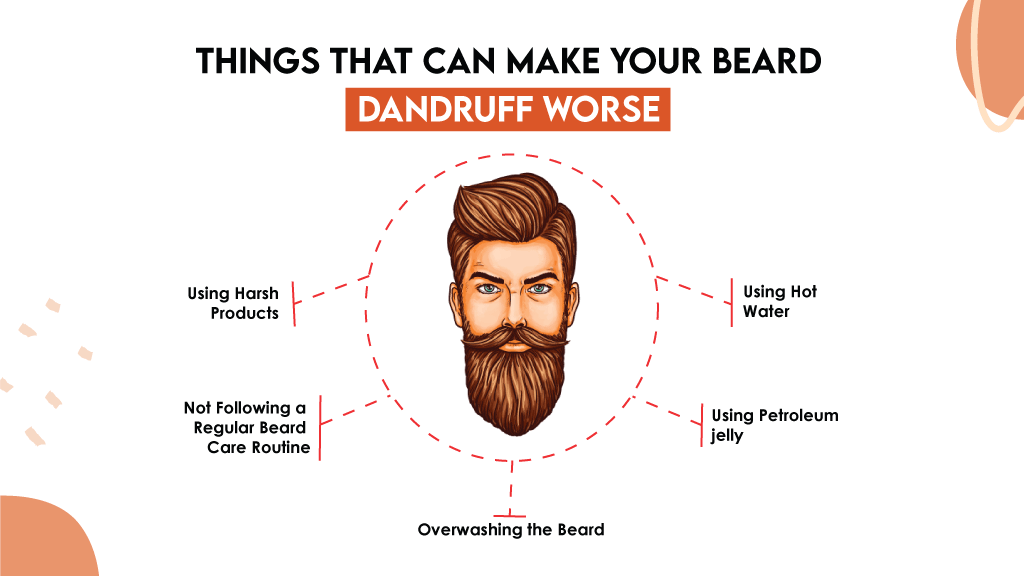
Now, we know how to get rid of dandruff in a beard, but did you know there are a few things that can actually make dandruff worse? Here are some of those small mistakes that we often make and end up with even more flaking and irritation.
-
Using Harsh Products
Using products with harsh chemicals, such as fragrances, parabens, sulfates, and phthalates, can strip away natural oils from the skin beneath the beard and leave it dry and irritated, which can worsen dandruff.
-
Not Following a Regular Beard Care Routine
Just like a proper skincare regimen, a beard care routine is also essential. It is important that you regularly wash your beard, brush it, trim it, and moisturize it to keep it healthy and flake-free.
-
Overwashing the Beard
Washing the beard regularly with a beard wash is essential, but overwashing it can lead to dryness, itching, and irritation of the skin. This is why you must wash your beard 2 to 3 times a week with a gentle cleanser, depending on your skin type and lifestyle. You may however need to give the beard a good rinse daily for proper hygiene.
-
Using Hot Water
Taking long, hot baths or using hot water to wash your beard can also strip away natural oils from the beard and leave it dry, rough, and irritated. This can lead to a never-ending itch-scratch cycle and make your dandruff even worse.
-
Using Petroleum jelly
Most people think that using petroleum jelly to moisturize the beard can help one get rid of beard dandruff. But the truth is, it can not treat dandruff and sometimes even makes it worse.
How to Prevent Beard Dandruff?
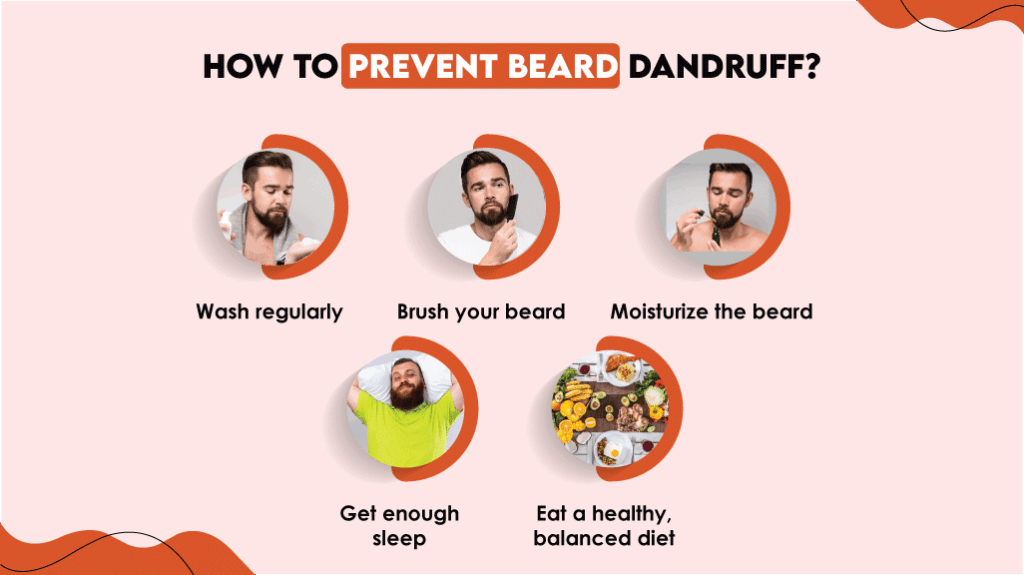
You cannot entirely prevent dandruff, as it is caused by everything happening in your body and skin, and you may have no control over it. However, by following a proper beard care routine, you can prevent the recurrence of dandruff flakes.
Here is how you can keep your beard healthy and prevent a dandruff flare-up:
- Wash regularly: Even after you have gotten dandruff under control, there is a chance it may come back. To prevent that, you can consult your doctor and use a medicated beard wash for dandruff once or twice a week to cleanse your beard and prevent the flakes from coming back.
- Brush your beard: Brush your beard daily in the morning. This will help increase the blood flow, distribute the sebum evenly on the beard, and remove any excess flakes.
- Moisturize the beard: It is essential to keep the beard and the skin underneath it moisturized and hydrated. Because sometimes dry skin can also trigger excessive sebum production and dandruff. You can moisturize your beard after washing it with the help of a beard balm.
- Get enough sleep: It may sound a little weird, but your body functions properly only when you get enough sleep. Getting enough sleep can help improve your beard’s health and keep various skin conditions at bay.
- Eat a healthy, balanced diet: What we eat can have an effect on our skin and hair. Consuming a healthy, balanced diet rich in minerals, vitamins, and protein can help keep your beard healthy and prevent beard flaking.
How Often Should You Wash Your Beard with Dandruff?
The general rule of thumb for washing a beard with a fragrance-free beard shampoo is about 2 to 3 times a week: 3 times for people who have oily skin or an active lifestyle, and 2 times a week for people with dry skin.
However, this frequency may vary from person to person. For some, washing their beard daily may lead to dryness and irritation, while for others, it may not. It is a trial-and-error process that you have to go through to check what works best for you.
However, if you have dandruff in your beard, try using a beard shampoo for dandruff 2 to 3 times a week or daily, depending on the severity of your condition.
Will Beard Dandruff Go Away if I Shave?
Most people think that shaving off the beard is an easy way to get rid of dandruff. It may help you get rid of the flakes temporarily, but it does not treat the root cause.
It is important to understand that dandruff is caused by everything that is happening on your skin, not your hair. This is why shaving will not help you get rid of it. Instead of shaving, the best thing for beard dandruff is to use anti dandruff shampoo for beards, infused with pyrithione zinc as an active ingredient to wash it and reduce the flaking and irritation associated with dandruff.
Facial Fortress for Beard Dandruff
Dr. Eddie often came across patients experiencing beard dandruff, many of whom used medicated shampoo for children to help clean the beard and reduce flaking and itching. This shampoo was free from harsh chemicals, making it a gentler option compared to traditional beard dandruff shampoos.
This inspired Dr. Eddie to develop a medicated anti dandruff beard shampoo for men that is free from harsh chemicals. Facial Fortress 3-in-1 Medicated Face, Hair, and Beard Wash is fragrance-free, sulfate-free, paraben-free, and BPA-free.
It is infused with 0.95% zinc pyrithione, which has been known to be effective in reducing flaking, itching, and irritation associated with dandruff and seborrheic dermatitis.
This beard wash can be used as a scalp shampoo and a face and beard wash at the same time, making it an all-in-one solution that helps reduce flaking on skin and hair. Plus, it contains natural ingredients like licorice root extract, apple fruit extract, and glycerin, which help soothe the irritated skin associated with dandruff.
Conclusion
In conclusion, beard dandruff is a common skin condition in men. However, it can be easily managed by following a proper beard care routine.
A few essential steps that you must incorporate into your routine are washing the beard 2 to 3 times a week with the help of medicated beard shampoo for dandruff, brushing the beard before washing it, and moisturizing it after washing.
However, there are also some common mistakes that you must avoid to prevent your dandruff from getting worse, such as using hot water, overwashing the beard, using natural remedies to get rid of dandruff, and using products with harsh chemicals.
Most dandruff shampoos contain harsh chemicals such as fragrances, parabens, and sulfates, which can irritate the skin and make your condition worse. So, the best beard dandruff shampoo is the one that is free from these harsh chemicals, such as the 3-in-1 beard, skin, and face wash by Facial Fortress.
- Can You Get Dandruff on Your Face? Causes, Symptoms & Effective Treatments - September 30, 2025
- Is it Dandruff or Dry Skin? How to Diagnose and Treat Flakes Under Your Beard - September 16, 2025
- Mustache Dandruff: Symptoms, Causes, and Treatment - July 29, 2025
Recent Post
Frequently Asked Questions
What causes facial dandruff?
How do I stop dandruff on my beard?
Is it ok to use dandruff shampoo on a beard?
What is the best beard wash for an itchy, flaky beard?
How to exfoliate a beard?
Can I wash my beard with just water?
- Can You Get Dandruff on Your Face? Causes, Symptoms & Effective Treatments - September 30, 2025
- Is it Dandruff or Dry Skin? How to Diagnose and Treat Flakes Under Your Beard - September 16, 2025
- Mustache Dandruff: Symptoms, Causes, and Treatment - July 29, 2025
